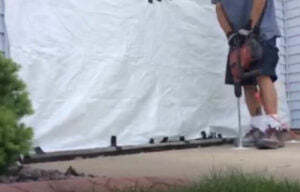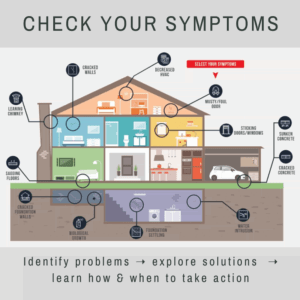Concrete Sidewalk & Patio Repair | Crawfordsville, IN?
 Concrete slabs are a universal component in housing. No matter where you live, or what kind of home you have, there’s likely a concrete slab somewhere on the property whether a concrete sidewalk or a concrete patio. Another universal? That these slabs will move and create problems for homeowners. Often, the best way to repair a sinking concrete sidewalk or patio is with a process called slabjacking. We specialize in concrete sidewalk repair and concrete patio repair in Crawfordsville, IN. Our concrete sidewalk and patio repair services are affordable and will help you maintain the proper appearance of these concrete structures.
Concrete slabs are a universal component in housing. No matter where you live, or what kind of home you have, there’s likely a concrete slab somewhere on the property whether a concrete sidewalk or a concrete patio. Another universal? That these slabs will move and create problems for homeowners. Often, the best way to repair a sinking concrete sidewalk or patio is with a process called slabjacking. We specialize in concrete sidewalk repair and concrete patio repair in Crawfordsville, IN. Our concrete sidewalk and patio repair services are affordable and will help you maintain the proper appearance of these concrete structures.
Acculevel was founded in 1996, and is well known in the industry for repairing foundations, basements, and crawl spaces. We raise and repair concrete sidewalks and patios for hundreds of customers per year and proudly serve Crawfordsville, IN. In this article, we’ll review what causes concrete sidewalks and patios to sink, how slabjacking works, and the benefits slabjacking offers.
Why does a concrete sidewalk or patio move?
Erosion
A concrete slab sinks as the soil underneath it shifts. Often, the cause for this is erosion- rain comes down and saturates the ground, mixing the water into the soil. Then, when the water drains away, it takes part of the soil with it. This erosion can happen gradually as a natural process, or suddenly if it’s caused by a broken pipe or ruptured drain. If the ground under a slab is eroding quickly or seems loose, you should evaluate your home’s guttering and plumbing systems. It’s possible the downspouts or plumbing are draining under the slab and washing out the soil.
Climate and Soil Type
In other circumstances, the slab moves because of the ground itself. It’s possible that it wasn’t properly compacted before the concrete was poured. The weather cycle in Indiana contributes another factor. The ground floods in the spring, then dries out during a summer drought, which prompts erosion Then there’s the midwestern winter freeze-and-thaw pattern. The ground expands when it freezes, and contracts as it thaws. This fluctuating also contributes to shifts in the soil, which accelerates the settling process.
Consequences
Concrete rarely settles evenly; usually one end will sink more significantly than the other. When this happens, the stress of the uneven support will sometimes crack the slab. At that point, you have high and low points on the concrete, and a crack or joint between slabs that will catch a pedestrian’s toe. These are trip hazards and a liability issue.
Sometimes, an uneven slab can also cause damage to your home. It may redirect rainwater towards your house, instead of away from it. This leads to water damage to your foundation, and possibly to leaks in your basement or crawlspace. Over time this extra moisture along a house can cause serious damage. Water permeating into your home can cause rotting in the structural wood flooring system (sill plate, floor joists, etc) and allow mold to flourish and grow.
How does slabjacking work?
Slab lifting is done by injection. Small holes are drilled through the concrete slab, and material is injected below it. This material fill the void underneath the concrete, and gradually the pressure of this filler being forced under the slab creates lift. The type of fill material varies; many companies use a concrete or limestone slurry referred to as “mud” and this process is generally called mudjacking. As the slurry hardens, it creates lift below the slab.
At Acculevel, we use a polyurethane foam. In our experience, slabjacking provides a better and more reliable repair; once the foam is injected, the chemical reaction promptly begins to expand, and it’s this foam that does the lifting. Since it’s more immediate than mudjacking, it allows for better control.
 This is a short, time-lapse video that demonstrates how slabjacking can lift concrete.
This is a short, time-lapse video that demonstrates how slabjacking can lift concrete.
Benefits
Convenience
The curing time for slabjacking is minimal. The polyurethane foam sets up quickly and cleanly. Unlike other fill materials, the foam solidifies within minutes; a patio can be walked on almost immediately, and you can drive on a garage floor within half an hour. Mudjacking uses a concrete mixture, so it must cure for a minimum of several hours before it’s “usable,” depending on the use of the slab, ground and air temperature, and the amount of moisture in the soil. (Temperature and moisture influence the cure time.)
Cleaner and Less Invasive
Slabjacking uses specialized equipment, but it’s usually installed in a standard-sized service truck that can park in the driveway or street without issue. Slabjacking repair work rarely requires an Acculevel crew driving across your lawn, or disturbing your landscape; the slabjacking equipment has a 250 foot injection hose to maximize our reach to the repair section.
In fact, there is very little mess generated at a slabjacking job site. Generally, crews only need to clean up some dust generated from drilling through the concrete, and maybe trace amounts of foam from the injection site.
This is preferable to the messy process of replacing a slab. Concrete demolition often involves the use of a jack hammer, which is noisy and creates debris that adds to landfills. Re-pouring concrete requires building forms, a concrete truck, and the use of this equipment in close proximity to the work site. This results in a significant amount of trash and upheaval on your property. The new slab can also be visually jarring, as it won’t match the other existing sections- in color or texture.
Lower Costs
Slabjacking works with the existing concrete slab, so the costs are limited. They depend more on the size of the slab being lifted, and the amount of void under the slab. (The larger the gap, the more material is required.) The costs to replace concrete can be double the price of slabjacking. For more details on costs, please review our article on costs comparisons.
The Next Step
Find an experienced specialty company, and make an appointment. Before you sign a contract for any service, you should always verify the company is reputable, insured, and accredited by the Better Business Bureau.
If you live in Indiana or the surrounding states, contact Acculevel. Established in 1996, we specialize in foundation repairs. If you have noticed sinking or cracking on any of your concrete slabs, you can request a free estimate. An experienced project manager will evaluate the sections of concern and recommend the best course of action for you, to keep your home strong and healthy for years to come.
GET A FREE INSPECTION AND ESTIMATE
Error: Contact form not found.
